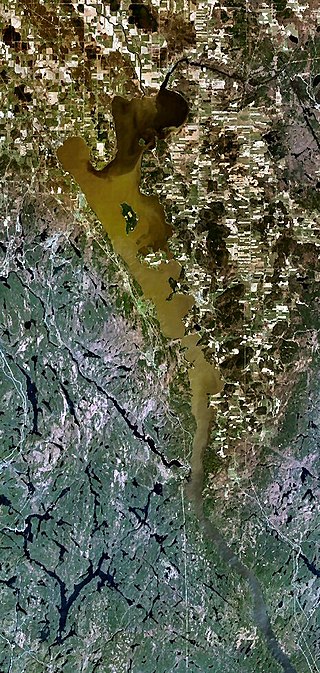
Timiskaming is a district and census division in Northeastern Ontario in the Canadian province of Ontario. The district was created in 1912 from parts of Algoma, Nipissing, and Sudbury districts. In 1921, Cochrane District was created from parts of this district and parts of Thunder Bay District.

Temiskaming Shores is a city in the Timiskaming District in Northeastern Ontario, Canada. It was created by the amalgamation of the town of New Liskeard, the town of Haileybury, and the township of Dymond in 2004. The city had a total population of 9,634 in the Canada 2021 Census. Temiskaming Shores is Ontario's second-smallest city, in terms of population, after Dryden. Haileybury is the seat of Timiskaming District.

Larder Lake is an incorporated municipal township and eponymous constituent dispersed rural community in Timiskaming District in Northeastern Ontario, Canada. It is located along Ontario Highway 66 and Ontario Highway 624 at the north-western part of the lake bearing the same name. The area of the township is 229.65 km2 (88.67 sq mi) and includes the geographic townships of Hearst, McVittie and Skead.

McGarry is an incorporated township in Timiskaming District in Northeastern Ontario, Canada. It includes the communities of Virginiatown and Kearns. The township borders with Quebec to the east, along Highway 66 between Kirkland Lake and Rouyn-Noranda. The northern border of the township forms part of the border between Timiskaming District and Cochrane District. Highway 66 was rerouted in 2017 because of concerns that aging mine shafts under the road could cause it to collapse.

Lake Timiskaming or Lake Temiskaming is a large freshwater lake on the provincial boundary between Ontario and Quebec, Canada. The lake, which forms part of the Ottawa River, is 110 kilometres (68 mi) in length and covers an area of almost 295 km2 (114 sq mi). Its water level ranges between 175 m (574 ft) and 179 m (587 ft) above sea-level, with a mean annual average of 178.4 m (585 ft). The lake is in places up to 216 m (709 ft) deep. There are several islands on the lake, notably Mann and du Collège Islands.
The Temagami First Nation is located on Bear Island in the heart of Lake Temagami, the second largest in Lake Temagami after Temagami Island. Its community is known as Bear Island 1. Temagami First Nation (TFN) members are status Indians under the Indian Act that live on and off Bear Island.

Notre-Dame-du-Nord is a municipality in the Canadian province of Quebec, located in the Témiscamingue Regional County Municipality. It is located at the northern end of Lake Timiskaming where the Ottawa River enters into this lake.

Fort Témiscamingue was a trading post from the 18th century in Duhamel-Ouest, Quebec, near Ville-Marie, Canada, located on the fur trade route on the east shore of Lake Timiskaming. The fort is a National Historic Site, operated as part of the national park system by Parks Canada, in partnership with the Timiskaming First Nation.

Larder Lake is a freshwater lake in Timiskaming District in Northeastern Ontario, Canada. The lake straddles the incorporated (municipal) townships of Larder Lake and McGarry and geographic McFadden Township. It is part of the Saint Lawrence River drainage basin and is the source of the Larder River.

The Blanche River is a river in the Saint Lawrence River drainage basin in Timiskaming District in northeastern Ontario, Canada. The river is a tributary of Lake Timiskaming and its name is from the French for the colour "white".

The Larder River is a river in Timiskaming District, in Northeastern Ontario, Canada. It is in the Saint Lawrence River drainage basin, and flows from its source at Larder Lake in geographic McFadden Township to its mouth as a left tributary of the Blanche River in the municipal township of Evanturel.
The Laberge River is a tributary of Lake Hebert, flowing in Canada, in:
Raven Lake is a freshwater body of Canada that straddles the boundary between Northwest in the province of Quebec, in Rouyn-Noranda, in administrative region of Abitibi-Témiscamingue, and Northeastern Ontario, in the District of Timiskaming. The dividing line between the two provinces is in the northeastern part of Raven Lake.

Ignace Tonené, also known as Nias or by his Ojibwe name Maiagizis, was a Teme-Augama Anishnabai chief, fur trader, and gold prospector in Upper Canada. He was a prominent employee of the Hudson's Bay Company.

The Kerr–Addison Mine is an abandoned Canadian gold mine in the Kearns area of McGarry, Ontario. In 1960, the mine was the largest producer of gold in North America. The mine produced the second most gold overall in North America, with the Homestake Mine being the leader.

Mount Kanasuta, often known as Mont Kanasuta, is a hilled area near the Quebec–Ontario border in the Abitibi-Témiscamingue administrative region of Quebec, Canada.
White Bear was a Temagami First Nation chief.
Peter Nebenegwune, commonly known as Nebenegwune, was the head chief, of the Temagami First Nation in Ontario, Canada.














